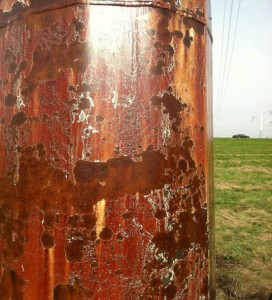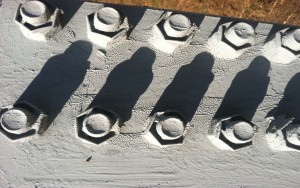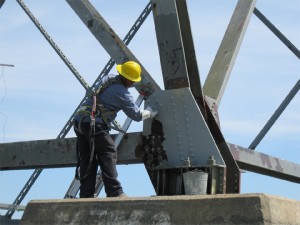
By Kendall Smith, Induron Sales Rep
Since the concept of protecting high-voltage electric transmission towers and poles with protective coatings began (in the early part of the last century), medium to long-oil alkyd primers have been used to spot-prime the more corroded areas and also to overcoat old aged coatings.
For four decades these primers provided the functionality for the extra protection needed to ensure proper performance of the high-build tower paint applied over it for tower preventative maintenance. Some of these primers were more reliable than others; with some of the medium to shorter-oil primers creating curing stresses that could lift old coatings at the edges.

Primers containing linseed oil were very effective, but were too soft to climb over the first few days, and needed about 3 days to topcoat. In recent years, epoxy technology has created 100% SBV penetrating sealers that solved this problem. This development has created an upgrade solution of the limitations of alkyd primers.
Below are some of the advantages of these newer class of coatings:
- Coating directly over rust or for overcoating shall be done with 100% SBV epoxy penetrating sealer.
- Surface Preparation: SSPC-SP 2 Hand Tool Cleaning and SSPC-SP3 Power Tool Cleaning; as required.
- Primer/Sealer: Induron E-BOND 100 PENETRATING SEALER @ 1.0-2.0 MILS DFT.
Desirable properties of a penetrant sealer or primer for use on concrete and rust include the following:
- No curing stresses that pull off old coatings caused by solvents and shrinking, as it is 100% SBV (Solvent-free) and unpigmented (zero or low shrinkage/internal stress).
- High degree of wetting, adhesion and capillary action (Very low viscosity and significant penetration into voids) and is applied in a thin film at 1.0-2.0 mils DFT.
- Tie-down existing old coatings; wick under loose edges and into tight crevices.
- A prolonged period where the penetrant sealer remains wet/tacky prior to full-cure. Does not become slippery as quickly as some other sealers.
- Tougher and more chemical resistant than alkyd primers.
- Upgrades the resistance properties of the full coating system.
- Optimal application via paint mitt, pound brush, roller, et. al.
- Compatible with any finish coat used in T&D.
Potential Disadvantages:
Recoat window varies depending on temperature vs. little to no recoat window for alkyd primers. (This has not been a concern for most T&D projects, as the crew will apply tower paint as soon as possible after application of the primer/sealer.)





